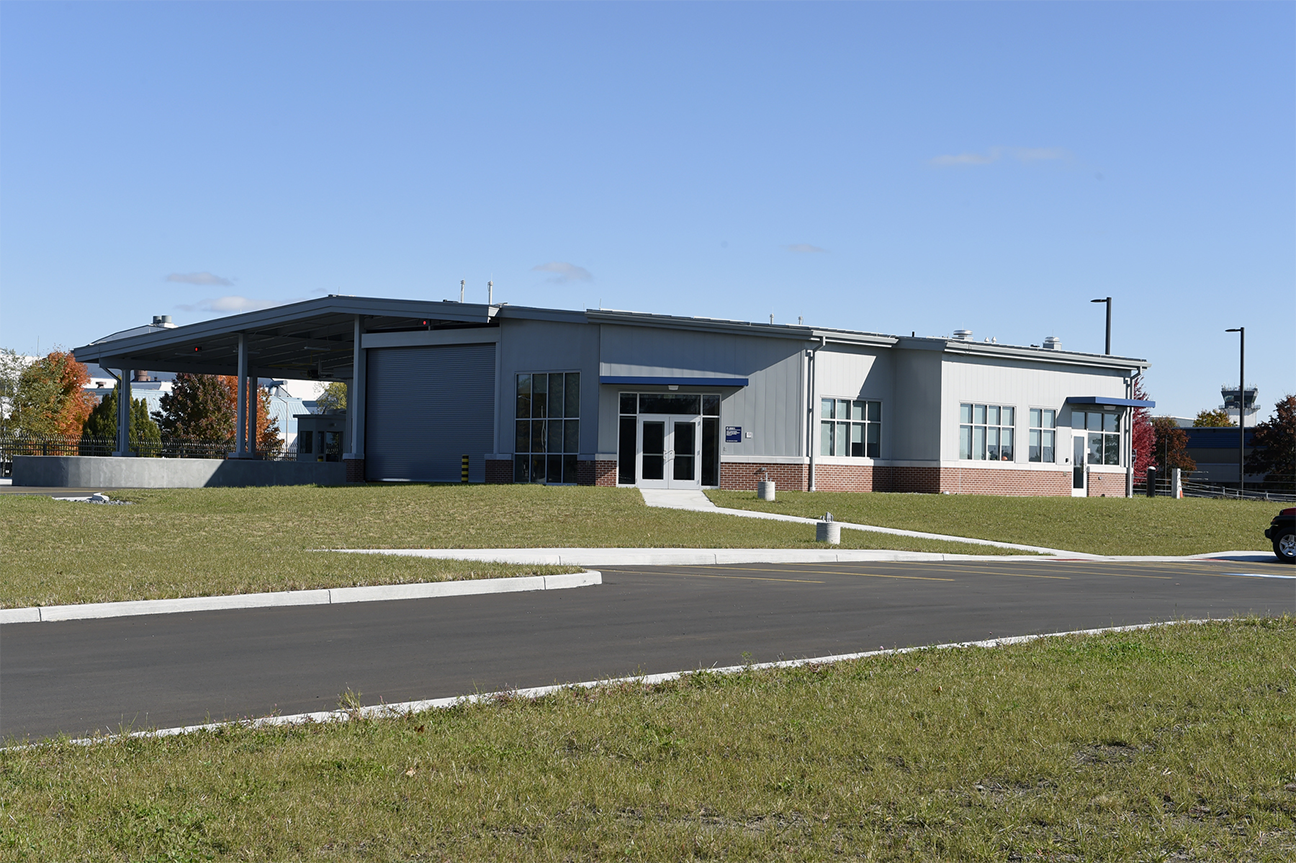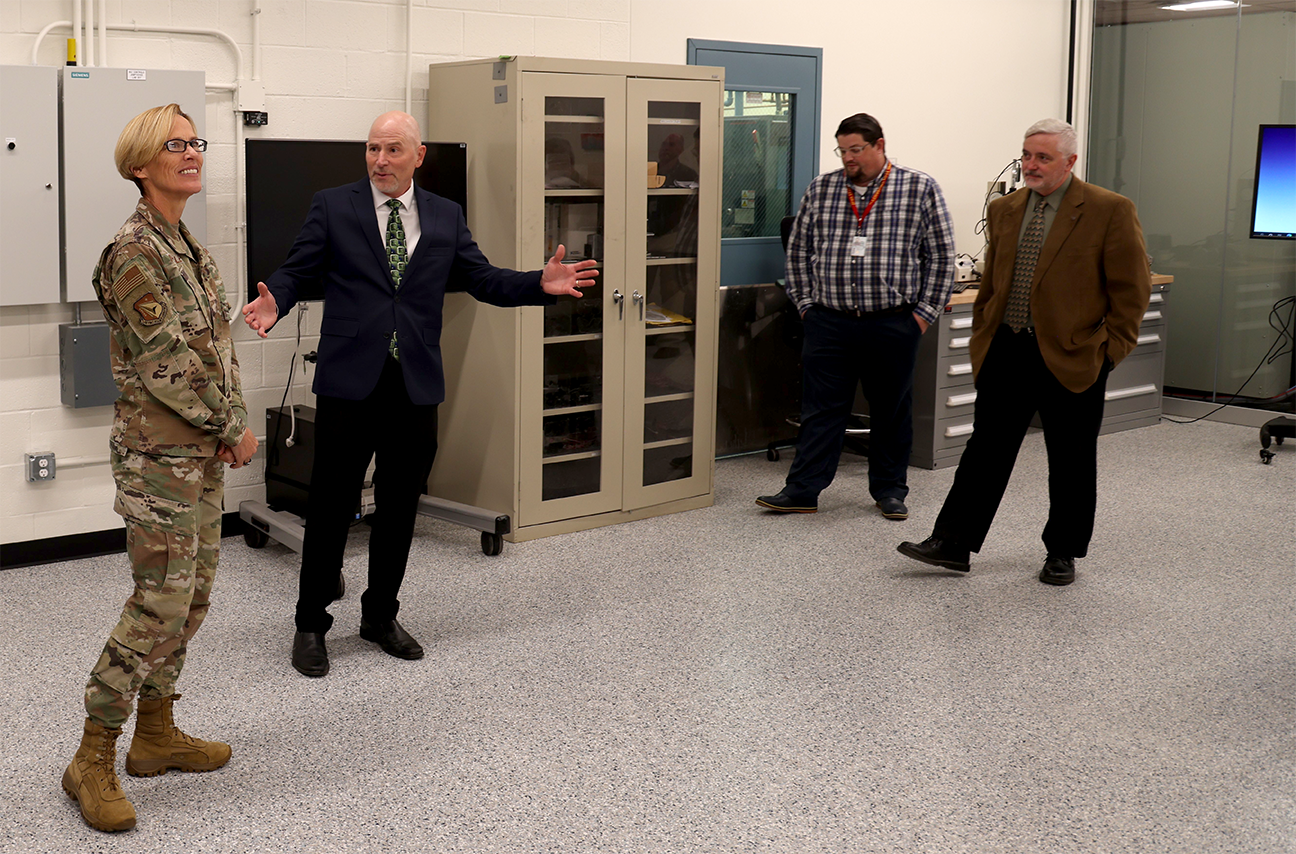AFRL infrastructure projects boost readiness, security
WRIGHT-PATTERSON AIR FORCE BASE, Ohio (AFRL) — While the Air Force Research Laboratory, or AFRL, is notable for developments inside the lab, a series of projects at AFRL sites across the U.S. is modernizing infrastructure and strengthening science and technology capabilities for national defense. These projects include new rocket fabrication machines in California, increased security measures in New York, a new radiation tolerance facility in New Mexico, facility renovations in Ohio and a new munitions facility in Florida.
“Installations play a critical role in AFRL’s ability to attract world-class talent and field leading-edge technologies,” said Maj. Gen. Heather Pringle, AFRL commander. “Expanding, securing and upgrading the infrastructure at AFRL enhances our mission effectiveness while we pay close attention to its cost-effectiveness and sustainability.”

Leaders from the Air Force Research Laboratory’s Space Vehicles Directorate, Army Corps of Engineers, and QA Construction, LLC break ground on the agency’s new Facility for Radiation Tolerance Research on Electronics for Space & Strategic Systems at Kirtland Air Force Base, New Mexico, Nov. 16, 2022. The facility will enable researchers to develop solutions for trusted, high-performance electronic components with necessary space and strategic-hardening to ensure the survivability of key U.S. Space Force and Air Force systems. (U.S. Air Force photo / Lt. Nina Rogers)

The Air Force Research Laboratory’s, or AFRL, Information Directorate, completes construction on a new perimeter fence and security entrance facility in Rome, New York, Nov. 1, 2022. AFRL upgraded its security measures with new state-of-the-art controls and facilities to welcome employees and visitors to the site. The new enhancements will secure the nation’s premier research organization for command, control, communications, computers and intelligence and cyber technologies. This upgrade is one of many projects at AFRL sites across the U.S. aimed at modernizing infrastructure and strengthening science and technology capabilities for national defense. (U.S. Air Force photo / Albert Santacroce)

The Air Force Research Laboratory’s Munitions Directorate hosted a dedication and ribbon-cutting ceremony for the lab’s newly constructed Advanced Munitions Technology Complex, or AMTC, at Eglin Air Force Base, Florida, Dec. 15, 2022. This military construction project, worth approximately $165 million, provides new test capability and modernizes much of the outdated 1960s infrastructure. AFRL designed the AMTC as a modern, collaborative research space that gives scientists and engineers the ability to experiment with new explosive materials and integrate them into complex munition designs. (U.S. Air Force photo / Keith Lewis)
At Edwards Air Force Base, California, AFRL upgraded its fabrication shop equipment in October 2022 with 20 new state-of-the-art machines for manufacturing rocket components that will enhance capabilities, increase accuracy and save money. These machines support the Rocket Propulsion Division, part of AFRL’s Aerospace Systems Directorate, which designs and manufactures components for liquid rocket engines and solid rocket motors.
According to an AFRL release, the newly upgraded fabrication shop allows the laboratory to manufacture unique, one-of-a-kind rocket components that scientists and engineers can test in experiments, such as proof of concepts for new technologies.
At AFRL’s Information Directorate in Rome, New York, the Army Corps of Engineers led military construction for the directorate’s complex modernizing security infrastructure. The $14.8-million project resulted in a new gate and entry point to ease access for the hundreds of vehicles that transit the gate every week.

Staff Sgt. Kevin Davis, a machinist with the Air Force Research Laboratory’s Aerospace Systems Directorate, operates one of AFRL’s new computer numerical control milling machines in the rocket fabrication shop at Edwards Air Force Base, California, Sept. 15, 2022. AFRL recently upgraded its fabrication capabilities with 20 new state-of-the-art machines for designing and manufacturing components for liquid rocket engines and solid rocket motors. The new equipment will increase accuracy, improve operator safety and save money. (U.S. Air Force photo / Joy Alich)
The upgrade is part of a process to bring AFRL’s gates into compliance with updated Department of the Air Force, or DAF, security requirements. The new gate, which opened Nov. 1, 2022, has increased capacity and security features that improve safety for the defenders who staff the gate and for those who pass through it.
The Information Directorate is the DAF’s and the nation’s premier research organization for command, control, communications, computers and intelligence and cyber technologies.
“Whether extending a perimeter fence or constructing a new research facility, these investments are critical to maintain AFRL’s standing as a top technological innovator. Equally important, they help position AFRL for future success as the technological competition intensifies and impacts our national security,” Pringle said.
AFRL leaders at Kirtland Air Force Base in New Mexico, broke ground Nov. 16, 2022, for the new Facility for Radiation Tolerance Research on Electronics for Space and Strategic Systems, a 6,200-square-foot, $4.5 million facility. The new facility enables researchers to investigate and develop solutions for trusted, high-performance electronic components. It also provides the necessary space and strategic hardening to ensure the survivability of critical systems in harsh, natural and human-made environments.
The facility is part of AFRL’s Space Vehicles Directorate, the DAF’s center of excellence for space research that develops and transitions technologies and provides space-based capabilities to the nation.
In November 2022, at Wright-Patterson Air Force Base, Ohio, the Accelerated Materials and Processing Solutions branch underwent an extensive makeover of its facility. Renovations included the installation of an additional computed tomography, or CT, machine and the construction of a brand-new suite to safely house the added equipment. CT refers to computerized X-ray imaging that can look for potential defects in aerospace-grade materials to ensure airworthiness and durability.

Air Force Research Laboratory, or AFRL, Commander Maj. Gen. Heather Pringle, left, surveys the newly-renovated Computed Tomography Laboratory, Nov. 9, 2022, at Wright-Patterson Air Force Base, Ohio, while John Brausch, center, Ryan Mooers and Steve Thompson, far right, welcome Pringle to the facility. The lab, part of AFRL’s Materials and Manufacturing Directorate, supports non-destructive testing of 3D-printed materials for the Department of Defense’s internal and external customer base. (U.S. Air Force photo / Jonathan Taulbee)
The lab, part of AFRL’s Materials and Manufacturing Directorate, supports nondestructive testing of 3D-printed materials for the Department of Defense’s internal and external customer base. AFRL’s Materials and Manufacturing Directorate develops materials, processes and advanced manufacturing technologies for aircraft, spacecraft, missiles, rockets and ground-based systems and their structural, electronic and optical components.
Most recently, AFRL hosted a ribbon-cutting ceremony Dec. 15, 2022, for the lab’s new Advanced Munitions Technology Complex, or AMTC, at Eglin Air Force Base, Florida. AFRL constructed the AMTC, a state-of-the-art complex, to ensure war-winning capabilities and support technologies today and into the future.
In the end, the facility, part of AFRL’s Munitions Directorate, cost approximately $165 million, not including equipment. The project provides unparalleled test capability and modernizes the 1960s high explosive infrastructure. AFRL designed the critical National Defense facility as a modern, collaborative research space that allows scientists and engineers to experiment with new explosive materials and integrate them into complex munition designs more efficiently.
About AFRL
The Air Force Research Laboratory, or AFRL, is the primary scientific research and development center for the Department of the Air Force. AFRL plays an integral role in leading the discovery, development, and integration of affordable warfighting technologies for our air, space, and cyberspace force. With a workforce of more than 11,500 across nine technology areas and 40 other operations across the globe, AFRL provides a diverse portfolio of science and technology ranging from fundamental to advanced research and technology development. For more information, visit: www.afresearchlab.com.
